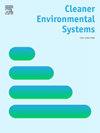通过等离子气化和厌氧消化结合碳捕获和储存的新型城市垃圾混合能源和燃料发电系统的经济和生命周期评估
IF 4.9
Q2 ENGINEERING, ENVIRONMENTAL
引用次数: 0
摘要
实现气候目标需要新颖的系统设计,能够将城市垃圾(如塑料和食物垃圾)转化为能源和燃料,同时对环境的影响最小。本研究提出了一种创新的多能发电系统,该系统集成了塑料垃圾的等离子气化和食物垃圾的厌氧消化,以及碳捕获和储存(CCS)技术。与传统的废物转化为能源(WtE)途径相比,这种新颖的概念设计旨在最大限度地提高能源回收,同时减少生命周期排放。评估了两种新型系统配置:(1)冷热电联产(CCHP)系统,以及(2)与液态生物甲烷生产集成的CCHP系统。每种配置都在三种CCS策略下进行了评估:不进行CCS、燃烧前CCS和燃烧后CCS。经济分析和生命周期评估(LCA)强调了每个设计的经济和环境权衡。具体而言,在场景1中,电力平准化成本(LCOE)从0.171美元/千瓦时(未进行CCS)增加到0.311美元/千瓦时和0.354美元/千瓦时,而在场景2中,生物甲烷平准化成本(LCObM)分别从0.176美元/千瓦时和燃烧后CCS增加到0.314美元/千瓦时和0.374美元/千瓦时。虽然CCS提高了生产成本,但它们也代表了减少排放的切实承诺,并强调向更清洁的能源系统过渡往往需要更高的近期支出。在这两种情况下,废物处理的平准化成本(LCOWT)为0.081-0.236美元/公斤废物。情景1的全球变暖潜势(GWP)范围为- 0.191至0.662千克二氧化碳当量/千克,情景2的GWP范围为0.123至0.746千克二氧化碳当量/千克。这项工作提供了这种混合WtE系统的第一个综合评估,为可持续废物增值提供了新的见解。提出的新设计支持未来详细的工程研究,并为低碳废物管理的政策制定提供信息。本文章由计算机程序翻译,如有差异,请以英文原文为准。
Economic and life cycle assessment of novel hybrid energy and fuel generation systems from municipal waste through plasma gasification and anaerobic digestion coupled with carbon capture and storage
Achieving climate goals demands novel system designs that enable the conversion of municipal waste, such as plastic and food waste into energy and fuels with minimal environmental impact. This study proposes an innovative multi-energy generation system that integrates plasma gasification for plastic waste and anaerobic digestion for food waste, coupled with carbon capture and storage (CCS) technologies. This novel conceptual design aims to maximize energy recovery while reducing lifecycle emissions compared to conventional waste-to-energy (WtE) pathways. Two novel system configurations were assessed: (1) a combined cooling, heating, and power (CCHP) system, and (2) a CCHP system integrated with liquid biomethane production. Each configuration was evaluated under three CCS strategies: no CCS, pre-combustion CCS, and post-combustion CCS. The economic analysis and life cycle assessment (LCA) highlight the economic and environmental trade-offs of each design. Specifically, in Scenario 1, the levelized cost of electricity (LCOE) increases from 0.171 USD/kWh (no CCS) to 0.311 and 0.354 USD/kWh while in Scenario 2, the levelized cost of biomethane (LCObM) rises from 0.176 USD/kWh to 0.314 and 0.374 USD/kWh for pre- and post-combustion CCS, respectively. While CCS raises production costs, they also represent a tangible commitment to reducing emissions and underscore that transitioning to cleaner energy systems often entails higher near-term expenditures. Across both scenarios, the levelized cost of waste treatment (LCOWT) spans 0.081–0.236 USD/kg of waste. Global warming potential (GWP) ranges from −0.191 to 0.662 kgCO2-eq/kg of feedstock for Scenario 1, and 0.123 to 0.746 kgCO2-eq/kg for Scenario 2. This work provides the first integrated assessment of such a hybrid WtE system, offering new insights for sustainable waste valorisation. The proposed novel designs support future detailed engineering studies and inform policymaking for low-carbon waste management.
求助全文
通过发布文献求助,成功后即可免费获取论文全文。
去求助
来源期刊

Cleaner Environmental Systems
Environmental Science-Environmental Science (miscellaneous)
CiteScore
7.80
自引率
0.00%
发文量
32
审稿时长
52 days
 求助内容:
求助内容: 应助结果提醒方式:
应助结果提醒方式:


